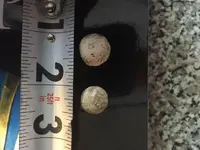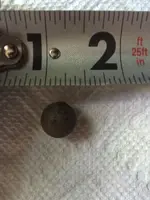How accurate is your scale? A British Brown Bess musket bore was .75 caliber, and it fired balls that weighed 12 balls to the pound. The paper cartridge for the Bess contained a ball of .69 caliber, way under size because because of powder fouling, and the fact that the paper cartridge was torn open, powder poured down the barrel, and the ball was rammed leaving all the paper from the cartridge, the ball had to be way undersized. .75 caliber means 3/4 of an inch, and .50 caliber means 1/2 inch. Calibers are 1/100 or even 1/1000 of an inch. The bullet should be weighed in grains for accuracy. Your measurements are in the ball park for a Brown Bess musket ball. .74 X 16 = 11.84 balls to the pound. Close enough for a pretty good guess, but not exact which requires exact weight and measurements in inch and grains. I have no idea what the copper ball would be, but I'd be willing to bet it has nothing to do with firearms. .50 caliber could be a rifle ball, they were fired with a greased patch on the ball, so there would probably be no rifling marks on the ball. Muskets were smooth bore, rifles had riflings in the barrel. Again, a .50 caliber rifle ball would be undersized by as much as 5/1000 of an inch, so the ball should mike out to .495 or so. That is unless it's been deformed from being fired. Anyhow, you are close enough for an educated guess, and I'd say yes, they are bullets from a muzzle loader. Dating them is another story. Patina helps, other stuff found in the area also helps. But I've shot and hunted with muzzle loaders up until just a couple of years ago, and I shot a replica Brown Bess and original rifles in in the same caliber of both your finds.





